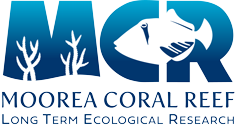Year:
2021
Authors:
Source:
Ecosystems
Abstract:
A fundamental goal in ecology is to understand the role of consumers in top-down (TD) and bottom-up (BU) processes that affect the functioning of ecosystems. Consumers ingest organic matter and excrete inorganic nutrients, and individual roles are influenced by body size and functional identity. Our study quantifies how alterations to herbivore assemblages affect both TD and BU processes on coral reefs in the South Pacific. We collected empirical data on consumption and nutrient excretion rates from 300 individual herbivorous fishes belonging to five functional groups. Individual-level traits were then scaled to a 13-year time series of fish populations from reefs that have either shifted to algal dominance or remained in the coral state. Large excavating parrotfishes and other herbivores on reefs in the coral state contributed 43% more herbivory and excreted nutrients at a higher ratio of N:P than herbivores on algal-dominated reefs; both processes may benefit coral health. Algal-dominated reefs experienced 56% higher rates of detritivory by large detritivorous fishes that remove detritus from algal surfaces, a process that may facilitate algal dominance. By scaling individual-level traits to population time series, our study provides a framework to quantify how changes to consumer assemblages impact both TD and BU processes across ecosystems undergoing change. Identifying the unique roles of consumers in processes that maintain and reinforce ecosystem states is the key to predicting the importance of shifts in diverse consumer assemblages.
Volume:
24
Pages:
1702-1715
Publication Type:
Journal Article



